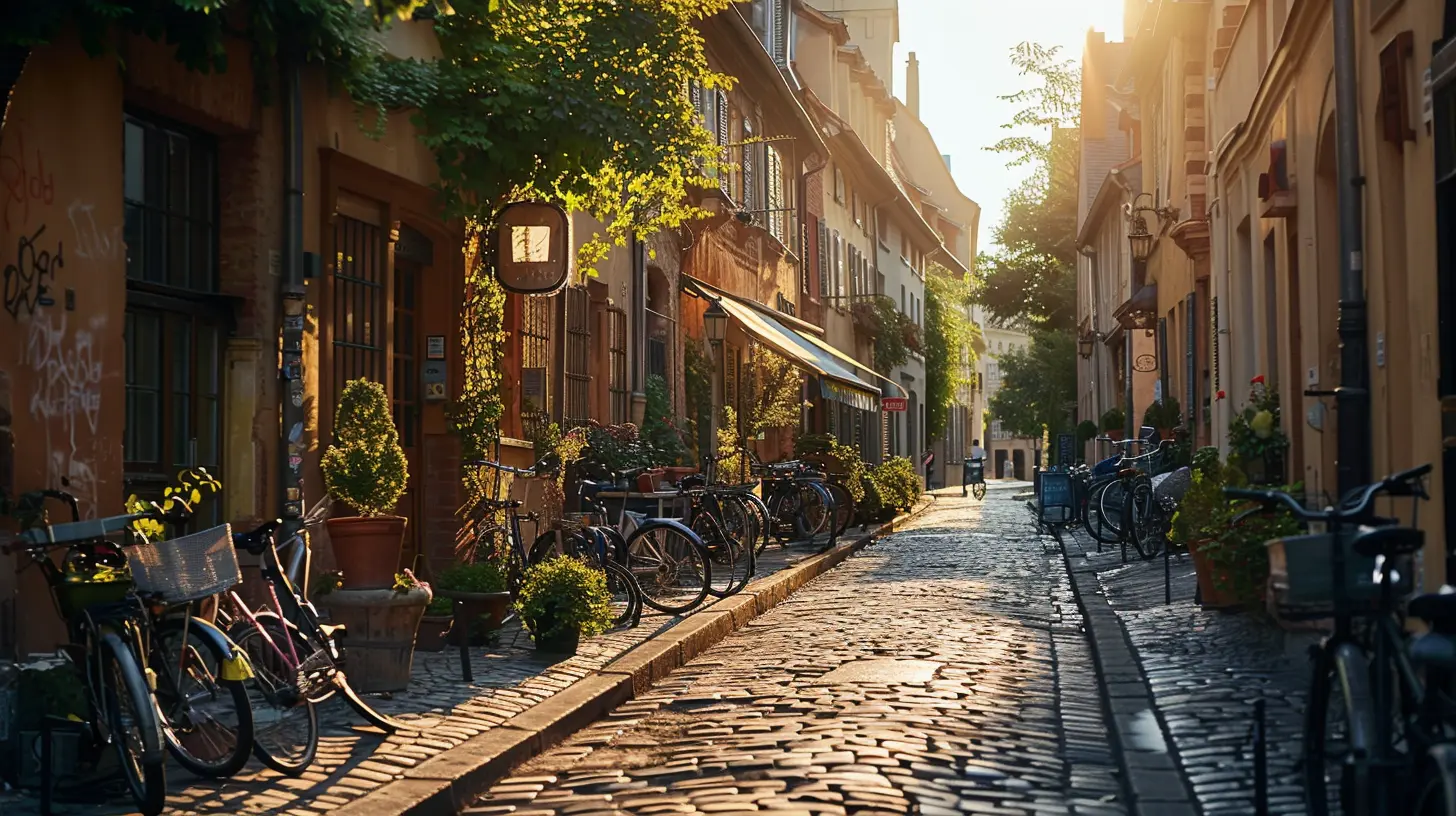Exploring the Charm of Walkable Cities
10 November 2025
Introduction
Imagine stepping outside your front door and having everything you need just a short walk away—cafés, parks, grocery stores, and even your workplace. No traffic jams, no endless search for parking, just the simple joy of strolling through lively streets. Sounds like a dream, right? Well, that's the magic of walkable cities.
Walkability isn't just a buzzword; it's a way of life that enhances convenience, promotes health, and fosters a strong sense of community. In an age where urban sprawl and traffic congestion are taking a toll on our daily lives, walkable cities offer an attractive alternative. But what makes a city truly walkable, and why should we care? Let’s dive in.

What Makes a City Walkable?
A walkable city isn’t just about having sidewalks; it's about creating an environment where people prefer to walk because it’s safer, more convenient, and simply more enjoyable. Several key factors contribute to a city’s walkability:1. Mixed-Use Development
Walkable cities combine residential, commercial, and recreational spaces in close proximity. That means you can grab a coffee, shop for groceries, and visit the park without needing a car. When everything is within walking distance, daily life feels effortless.2. Pedestrian-Friendly Infrastructure
Wide sidewalks, well-lit pathways, bike lanes, and pedestrian crossings make a city more inviting. When streets are designed for people rather than just cars, walking becomes a pleasure rather than a challenge.3. Efficient Public Transportation
Even in walkable cities, some trips require public transport. A well-connected transit system complements walkability by making it easier to move around without a car. People can hop on a bus or train for longer trips and walk the remaining distance.4. Green Spaces and Public Areas
Parks, playgrounds, and plazas add to the charm of walkable cities. They provide spots for relaxation, social gatherings, and outdoor activities, making walking not just a necessity but a joy.5. Safety and Accessibility
A truly walkable city ensures pedestrian safety with clear crosswalks, traffic calming measures, and well-maintained sidewalks. Additionally, ramps and accessible pathways make walking easy for people of all abilities.
The Benefits of Living in a Walkable City
Still wondering why walkability matters? The benefits go beyond just convenience.1. Better Physical and Mental Health
Walking is one of the easiest forms of exercise, helping to reduce the risk of obesity, heart disease, and diabetes. But it’s not just about physical health—walkable environments also contribute to better mental well-being. A simple stroll can reduce stress, enhance creativity, and lift your mood.2. Stronger Sense of Community
Ever noticed how people in walkable neighborhoods seem more connected? That’s because frequent, casual interactions—bumping into a neighbor, chatting with a shop owner, or meeting friends at a local café—help build relationships. Walkability fosters a sense of belonging that’s hard to find in car-dependent cities.3. Economic Growth and Local Businesses
Walkable cities are great for local businesses. When people walk through a neighborhood rather than drive past it, they’re more likely to stop and support small shops, restaurants, and services. This boosts the local economy and creates vibrant, thriving communities.4. Reduced Traffic and Pollution
Fewer cars on the road mean less traffic congestion and cleaner air. Walkable cities contribute to lower carbon emissions, making them a sustainable choice for the future. With climate change becoming a pressing issue, embracing walkability is a step in the right direction.5. Increased Property Value
Homes in walkable neighborhoods tend to have higher property values. People are willing to pay a premium for the convenience and quality of life that walkability provides. Real estate trends show that urban walkability is becoming a key factor in homebuyers' decisions.
The Best Walkable Cities in the World
Some cities have mastered the art of walkability, offering residents and visitors an unmatched pedestrian-friendly experience.1. Copenhagen, Denmark
Copenhagen isn’t just bike-friendly—it’s also an incredibly walkable city. With pedestrian-only streets, urban parks, and a culture that prioritizes people over cars, it's a prime example of how cities can be designed for walking.2. Amsterdam, Netherlands
Known for its canals and charming streets, Amsterdam is a walker’s paradise. The city’s compact layout, combined with a seamless public transport system, makes walking the preferred mode of travel for many locals.3. Portland, Oregon, USA
Portland is one of the most walkable cities in the U.S., boasting mixed-use neighborhoods, a reliable public transit system, and plenty of green spaces. Whether you’re strolling through the Pearl District or exploring the city’s markets, walking here is a delight.4. Barcelona, Spain
Barcelona’s distinct grid layout and pedestrian-friendly streets make it one of the most inviting cities for walking. The famous Las Ramblas offers a perfect example of a lively, walkable space where people gather, shop, and socialize.5. Kyoto, Japan
With its narrow streets, historic temples, and beautiful gardens, Kyoto is an exceptional city for pedestrians. Walking through Kyoto feels like stepping into a different era, where every street holds a piece of history.
How to Make Cities More Walkable
Not all cities are naturally walkable, but urban planners and policymakers can take steps to improve walkability.1. Invest in Pedestrian Infrastructure
Prioritizing sidewalks, crosswalks, and pedestrian zones can make walking safer and more attractive. Adding benches, shade, and lighting enhances the walking experience.2. Encourage Mixed-Use Development
Zoning policies should promote mixed-use areas where people can live, work, and play without needing to drive. The closer amenities are, the more walkable a neighborhood becomes.3. Improve Public Transportation
A well-integrated public transport system reduces the dependency on cars. If people can walk to a bus stop or train station with ease, they’re more likely to choose sustainable transportation options.4. Implement Car-Free Zones
Many cities are experimenting with car-free streets, where pedestrians and cyclists have priority. These areas create lively public spaces that enhance community interaction.5. Promote Walkability in Urban Planning
City planning should prioritize people over cars. Designing streets with pedestrians in mind ensures that walking becomes a natural, enjoyable part of daily life.The Future of Walkable Cities
As cities continue to evolve, walkability will play a crucial role in shaping urban life. With more people prioritizing convenience, sustainability, and quality of life, the demand for pedestrian-friendly spaces is growing. Advances in technology, such as smart city design and real-time pedestrian tracking, will further enhance the walking experience.Real estate developers and city planners have a unique opportunity to embrace walkability. Investing in pedestrian-friendly infrastructure isn’t just a trend—it’s a long-term solution for creating vibrant, livable cities.
Final Thoughts
Walkable cities are more than just places to live; they're communities where life feels easier, healthier, and more connected. Whether you're considering moving to a walkable city or advocating for better urban planning in your hometown, one thing is clear: walkability matters.So, the next time you're stuck in traffic, imagine a world where your daily routine involves a pleasant walk instead of a stressful commute. Because in walkable cities, life doesn’t just pass you by—you get to be part of it.
all images in this post were generated using AI tools
Category:
Urban LivingAuthor:

Camila King
Discussion
rate this article
1 comments
Fallon McQuiston
Walkable cities invite connection and community, transforming our daily lives into vibrant experiences. Embracing these charming urban landscapes not only enhances our well-being but also fosters a sense of belonging and adventure. Let's celebrate the beauty of walkability!
November 10, 2025 at 4:41 AM

Camila King
Thank you for highlighting the transformative power of walkable cities! I completely agree that they enrich our lives and strengthen community ties. Let's continue to celebrate and advocate for these vibrant urban spaces!


